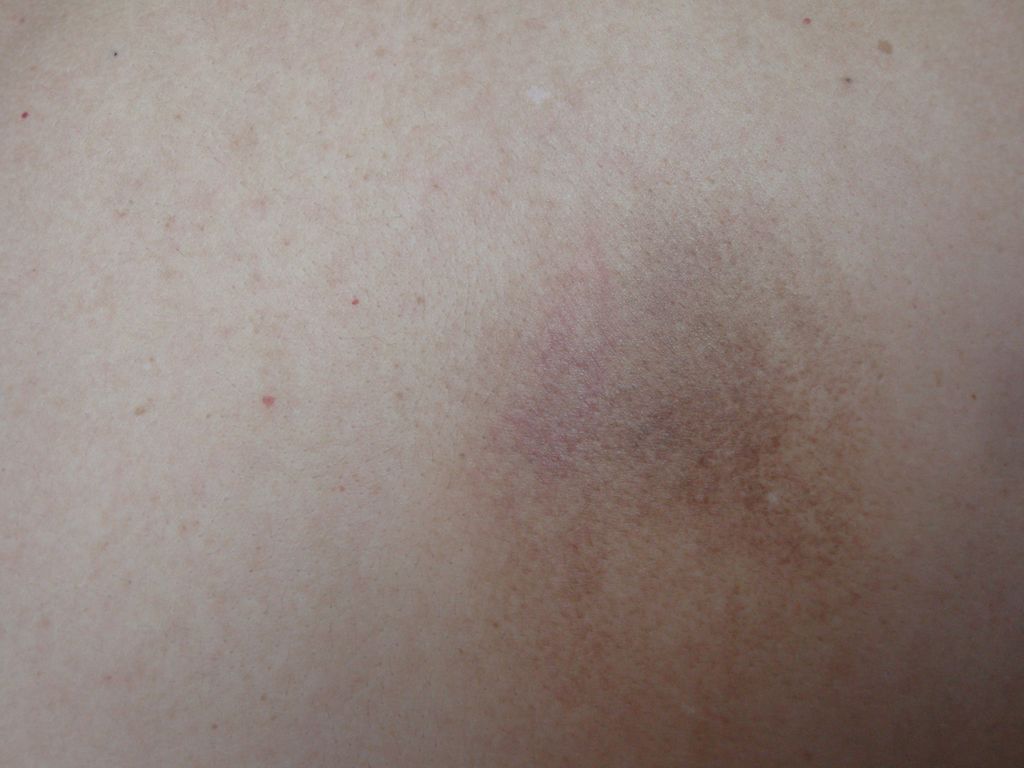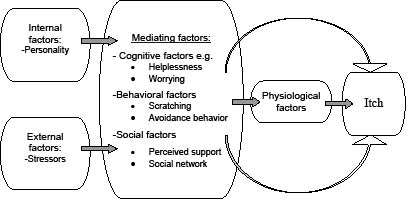The molecular and cellular mechanisms of systemic itch, such as cholestatic pruritus, are beginning to be explored. Perception of an itch sensation in the brain can be affected by many psychosocial factors, and psychogenic itch can be generated by solely visual stimuli. The most common skin complaint in the elderly is pruritus, but the multitude of possible etiologies make diagnosis and management a challenge. ABSTRACT: Itch and pruritus are two terms for the same thing. In this essay I will argue that casting about for a distinction between them creates only confusion. Once that matter is settled, it is still necessary to come up with a clinical classification for itches of different types. Currently, management of pruritus in the elderly must take an individualistically tailored approach with consideration of the patients general health, the severity of. The itch felt is a neuronal projection of a centrally formed sensation into defined regions causing localised pruritus or into large areas of the body surface causing generalised pruritus. The afferents for mediating the itch sensation are probably a group of Cfibres with thin. Pruritus, or itch, is a common complaint in patients with cholestatic liver disease. Several mechanisms are generally accepted as possible explanations to the underlying basis of itch. The Bernhard award is in honor of Jeff Bernhard, a renowned dermatologist, former EditorinChief of the Journal of the American Academy of Dermatology, and author of the first book on itch in 1994, entitled Itch: mechanisms and management of pruritus. Mechanisms of Pain and Itch Caused by Herpes Zoster (Shingles) Author exclusive and study of more patients with PHI and other types of neuropathic itch will be needed to understand the mechanisms of neuropathic itch. BernhardNeurogenic pruritus and strange skin sensations, in Bernhard J (ed): Mechanisms and Management of Pruritus. Pruritus is a symptom found in patients with chronic liver diseases, especially cholestatic liver diseases such as primary biliary cholangitis. This symptom impairs patient quality of life by disturbing sleep and may lead to consideration of liver transplantation. Mechanisms implicated in pruritus. The elderly in North America is the fastest growing segment of the population and their most common skin complaint is pruritus. This article outlines the therapeutic challenges with this population. Patient first presented reporting severe itch with excoriated, Brachioradial pruritus (BRP) is a form of neuropathic itch characterized by localized itching, burning, such as gabapentin and pregabalin, may be particularly helpful in the management of BRPtriggered generalized pruritus. Pruritus or itch is defined as an unpleasant sensation of the skin that provokes the urge to scratch. It is a characteristic feature of many skin diseases and an unusual sign of some systemic diseases. 1, 2 Pruritus may be localized or generalized and can occur as an acute or chronic condition. Post burn pruritus is a well recognised symptom in almost all burn patients. Yet, there is insufficient awareness about the etiopathogenesis and a lack of a systematic approach in the assessment and treatment of this distressing symptom. Itch: Mechanisms and management of pruritus Jeffrey D. Bernhard, MD, editor, New York, 1994, Mc Inc. Bernhard, known to readers as the author of inter esting tidbits about pruritus that have arrived in the mail through various vehicles, has assembled contributors with knowledge and interest in mechanisms, diagnosis. Itch, also known as pruritus, is defined as an unpleasant cutaneous sensation which provokes the desire to scratch. 1 Itch may be classified by its mechanisms. It is typically divided into one of several categories: pruritoceptive, neurogenic, neuropathic, and psychogenic. 2 Pruritoceptive itch originates in the skin, is mediated locally by. Itch (pruritus) is one of the most disabling syndromes in patients suffering from skin, liver, or kidney diseases. Our previous study highlighted a key role of oxidative stress in acute itch. Here, we evaluated the effects of antioxidants in mouse models of acute and. In Itch, Jeffrey Bernhard provides dermatologists and all other physicians who manage skin disease a muchneeded reference about what is known and what is not, as well as specific recommendations about the evaluation and treatment of patients with pruritus. Note: Citations are based on reference standards. However, formatting rules can vary widely between applications and fields of interest or study. The specific requirements or preferences of your reviewing publisher, classroom teacher, institution or organization should be applied. Itch: Mechanisms and Treatment presents a timely update on all aspects of itch research and the clinical treatment of itch that accompanies many dermatological conditions including psoriasis, neuropathic itch, cutaneous tcells lymphomas, and systemic diseases such as. Extrapolating from the known mechanisms of NP, phantom itch might have peripheral mechanisms (stump itch), reflecting ectopic activity of damaged primary afferents, and central mechanisms such as loss of tonic inhibition. Two chapters discuss the pathophysiologic aspects of itch, 12 chapters discuss pruritus associated with skin diseases, 10 discuss pruritus associated with systemic diseases, 1 discusses. Dry skin can directly cause pruritus, and in many cases, it is also one of the symptoms of chronic itch conditions, such as atopic dermatitis, cholestatic pruritus, and uremic pruritus. A dryskin mouse model was established by Kuraishis group ( 94 ) in 2002. Itch Mechanisms and Management. 31 was shown to have a pivotal role in severe itch and AD. which has a role in pruritus induction in urticaria (Tedeschi et al. In addition to the release of neurotrophins. Pruritus is a common symptom that occurs in a wide variety of clinical settings, such as dermatologic disorders, neuropathic disorders, and systemic or psychiatric disease. Management and treatment of pruritus skin therapy letter, pruritus, or itch, is a common sensation that causes a person to want to scratch it is a complex process that may negatively impact quality of life this overview provides information Diagnosis, treatment and management of pruritus Abstract Pruritus is a ubiquitous symptom with a wide range of presentations, often causing considerable distress for many individuals and resulting Pruritus is a symptom arising from a plethora of dermatological, neurological, and systemic conditions. The pathophysiological mechanisms involved in the transmission of acute and chronic pruritus are Although there is still much to be learnt about the mechanisms of pruritus, appropriate nursing interventions can be pivotal to the success of treatment. This article focuses primarily on the diagnosis, treatment and management of pruritus resulting from common dermatological causes. The fivepart organization includes basic pathophysiology of pruritus, dermatologic aspects of itching, systemic causes of itching including drug reactions, AIDS, liver disease, and more psychologic and psychiatric aspects of itching, and treatment including topical. Pruritus can develop at any stage of cholestatic liver disease and it should be particularly noted that severity of cholestatic itch is independent of the duration, biochemical severity, and histological stage of the underlying liver disease. Recent advances in the management of pruritus in chronic liver diseases Kazuto Tajiri, Yukihiro Shimizu Kazuto Tajiri, Department of Gastroenterology, Toyama MECHANISMS OF PRURITUS IN LIVER DISEASES mechanisms underlying itch signaling is complicated. GUIDELINES FOR THE MANAGEMENT OF PRURITUS IN PALLIATIVE CARE 34. 1 GENERAL PRINCIPLES mediated itch is associated with the sedative effect of the drug. 1 Meeting on Management of Pruritus in Palliative Care. Chronic pruritus, which is defined as itch persisting for more than 6 weeks, 1 is The mechanisms underlying the various types of chronic pruritus are complex. Most dermatologists cringe when a patient complains I itch all the time and there is little to see on physical examination. Jeffrey Bernhard has had a long interest in these challenging patients, and now he and a group of skilled contributors have produced a clinically oriented text to help all of us deal with the many variants of itch. Uremic pruritus a review Prasad PVS, Kaviarasan PK, Nethra T and Kannambal diagnosis and management. The pathophysiology remains unexplained. There may be an imbalance between the antagonistic activities of and opioid receptors. A number of different mechanisms have been proposed like xerosis, transdermal water loss. Mechanisms underlying pruritus Itch, like pain, can originate anywhere along the neural itch pathway, from the central nervous system (brain and spinal cord) to the peripheral nervous system and the skin. Itch: Mechanisms and Treatment presents a timely update on all aspects of itch research and the clinical treatment of itch that accompanies many dermatological conditions including psoriasis, neuropathic itch, cutaneous tcells lymphomas, and systemic diseases such as. The treatment for pruritus of systemic disease varies depending on the underlying etiology. New therapies are based on advances in the understanding of the mechanisms that cause pruritus. However, without eradication of the underlying systemic disease, treatment is. Pathophysiology and Management of OpioidInduced Pruritus of the mechanisms causing opioidinduced pruritus and the pharmacological therapies available to prevent andor manage this disorder. widespread, peripheral vs central), and the mechanisms of neuropathic itch are poorly understood, resulting in reduced treatment availability. Currently available strategies include treating or preventing causal diseases, such as Wound pruritus: pathophysiology and management Julia C Paul School of Nursing, Oakland University, Rochester, MI, USA Purpose: The objective of this article is to review literature on wound pruritus, with a focus on summarizing pathophysiology and management. Pruritus (itch) is the most frequent symptom in dermatology (Serling, Leslie, Maurer, 2011). Itch is the predominant symptom associated with acute and chronic cutaneous disease and is a major symptom in systemic disease ( Elmariah Lerner, 2011; Steinhoff, Cevikbas, Ikoma, Berger, 2011 ). Although pruritus is a common adverse effect of opioids, the itch intensity ranges from mild to severe with 50 to 60 of patients requiring treatment after epidural morphine administration. Nalbuphine is better than naloxone for treatment of side effects of epidural morphine. In terms of possible aetiological mechanisms in the elderly, pruritus can be attributed to a diverse array of underlying aetiological whether a rash is associated with the pruritus (is it an itch without a rash or a rash that itches? Evaluation and management of pruritus and scabies in the elderly population. ing morphineinduced pruritus suggested that cen1. 6 Other Mechanisms tral D 2 receptors may also contribute to OIP or Antagonism of GABA and glycine receptors in Pruritus (itch) is a common symptom, rather than a specific disease entity, that occurs in a diverse range of skin diseases and may appear as a prominent feature of extracutaneous disorders such as systemic, neurologic, and psychiatric diseases. Pruritus: causes and management Pruritus, or the desire to scratch, is a common skin condition that increases in incidence with in an itch are histamine and the neuropeptide substance P. Although often perceived as trivial, cause pruritus. The mechanisms postulated are dry Druginduced itch is defined as generalized itching without skin lesions, caused by a drug. Itching associated with druginduced cholestasis is among the common dermatologic adverse events (dAEs) that induce itching. Pruritus is the predominant symptom of skin disease and can be defined indirectly as a sensation that leads to a desire to scratch. Patients with dry skin such as chronic renal disease and atopic dermatitis often complain of intense itching and excessive scratching. However, the precise mechanisms.











